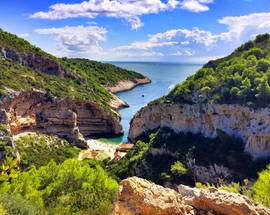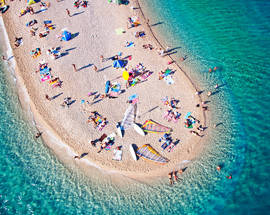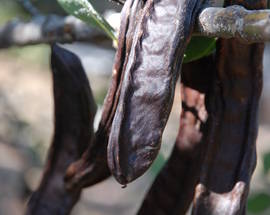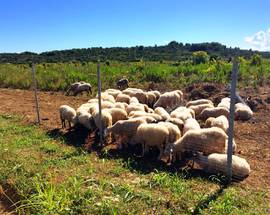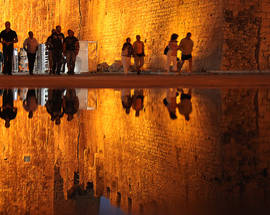Jump to:
- North of Split
- Trogir
- Marina
- Kaštela
- Solin
- Klis
- South of Split
- Podstrana
- Islands
- Šolta
- Brač
- Hvar
- Sinj
- Top Sights
North of Split
Some might say that Trogir is the ‘mini-me’ of Split, it’s a fine pit stop as it is a UNESCO World Heritage Site with its medieval stone churches, monasteries, palaces and squares. Our tip is the Kamerlengo Fortress which has grand views for taking photos. For another step back in time the town of Solin, which is an ancient Roman settlement and happens to be the birthplace of Emperor Diocletian still has its well preserved amphitheatre, town gate, fortress and other historical buildings.Trogir
Similar to Split, its neighbor town just a short distance away, Trogir is yet another Croatian town that possesses incredible historical and architectural traditions, both of which have been built upon by a progression of generations during the past 2,300 years. Walking the streets of Trogir's old town, one encounters Romanesque, Gothic, Baroque and Renaissance architecture and artwork, juxtaposed with modern stores and shop fronts, making Trogir a fascinating amalgamation of architectural styles from different eras.Founded in the 3rd century BC by Greek settlers from the island of Vis, Trogir was an important port in the region until well into the Roman era, when its importance was diminished by the rise of Salona. Again, like so many other coastal Croatian cities, Trogir underwent a tumultuous series of victories, defeats, periods of autonomy and periods of subservience to outside governments, with the city finally coming under Venetian rule from 1420 to 1797.
While the former rulers of the region were interested in Trogir for its strategic location, visitors to the city today are interested in the structures that dwell inside the walls of the city's old town. Of particular importance are the churches and buildings dating from the 13th century; the Duke's palace, which dates from the 13th century; and perhaps most impressive of all, the Cathedral of St Lawrence and the Portal of Radovan. Radovan, a master artist and Trogir native, created the intricate entryway to the cathedral in 1240.
The cultural and historical significance of the town and its architecture were verified in 1997 when UNESCO (the United Nations Educational, Scientific and Cultural Organization) added Trogir to its list of protected world heritage sites, marking the beginning of a new era in Trogir's history. While traditionally an economy focused on agriculture and fishing, this new era of the city's development will almost definitely be focused on tourism, as Croatia's coast becomes an increasingly popular destination for tourists from around the world.
Marina
Marina, a municipality in the Split-Dalmatia County, is located in the center of Dalmatia. It’s situated exactly halfway in between the UNESCO protected cities Split and Šibenik and 12km from Trogir. The settlement is surrounded by picturesque fortifications, such as the quadrangular tower the bishops of Trogir built in the 15th century, Drid hill containing remnants of old stone houses scattered throughout the former Dridske county, as well as the St. Philip and Jacob's Cave, famous for having been visited by Emperor Franz Joseph I in the year 1891. The Marina Riviera consists of three small picturesque Dalmatian towns: Vinišće, Poljica and Sevid, which overlook the crystal clear blue waters and sandy beaches. In the surrounding Zagora region, original Dalmatian traditions and customs, folklore costumes and local gastronomy are still preserved. This area is rich in ancient olive groves and is widely known for producing olive oil. As well, numerous bike paths in this region allow for a great way to explore this time-honoured area.Kaštela
Between Split and Trogir, 20 km to the south, lies a sequence of seven small towns known collectively as ‘Kaštela’ (Castles), each centred on its own fortress. If you drive along route 8 from Split towards Trogir you will see signs directing to (Kaštel Sućurac, Kaštel Gomilica, Kaštel Kambelovac, Kaštel Lukšić, Kaštel Stari, Kaštel Novi, Kaštel Štafilić). Most were constructed in the 16th century to provide shelter from marauding pirates or Turks. It would take the better part of a day to check out their interesting architectural features. Of particular interest is the newly built Marina Kaštela which accommodates private and charter boats. In Kaštel Sućurac, sits the oldest defensive fortress which was built in 1392 by the Archbishop of Split A. Gvaldo. In Kaštel Gomilica in front of the church, there is an oak tree over 700 years old, under which, according to the legend, Croatian king Zvonimir rested. And that’s just the beginning. All are accessible by car.Solin
Solin, aka Salona in Italian and Latin, stands 8 kilometres outside of Split at the meeting point of the River Jadro and the Adriatic Sea and was at one time the largest Roman settlement on the eastern coast of the Adriatic sea. One of its primary historical distinctions is that it was the birthplace of Emperor Diocletian who, as we hope you know by now, erected his palace in Split and spent the rest of his days there. Solin also probably played a role in Christianity's early history. According to the Bible, Paul's student Titus traveled to the region and, because of its sea connections with Italy and the Middle East, it is likely that Solin would have attracted such emissaries of Christianity. In any event, the town's role as a crossroads of cultures and religions left behind an archaeological legacy that has earned the town the title of "Croatia's Pompeii".Until recently, Solin depended on its cement and asbestos factories as its principal industries, which did little to enhance the image of the town. Today, due to excavations exposing the remains of the former Roman town located nearby, tourists from Trogir and Split are giving the town a much-needed economic boost. In turn, they receive the possibility to stroll among ancient ruins that are over two thousand years old. In response to this increase in tourism, Solin has dedicated itself to highlighting and preserving its natural attractions as well. The River Jadro has been carefully preserved and is dotted with loads of green areas that are a pleasure to stroll through as well, especially if you're not thrilled by the idea of exploring ancient ruins. In the end, Solin makes for a lovely day-trip from Split or Trogir and, considering the wealth of history ready to be explored there, just might be one of the best-kept travel secrets in the country that is just slightly off the beaten path.
Klis
One of the largest, most spectacular and yet easily accessible fortresses in the county is Klis, planted precariously on sheer cliffs just inland from Split. There’s an excellent view of this fortress from the highway that connects Split with the A - 1 highway. Partially restored and now an outdoor museum, the fortress is well signposted from the road. It will take you at least an hour to explore the fortress and soak in the great views in every direction. There is a café right below the fortress.Klis has had a long and colorful history. It was first mentioned in written records in the first half of the 10th century. In the 13th century the Mongols invaded the area but never succeeding in taking the fortress. The Ottoman Turks captured it in 1537. Local nobles succeeded in retaking Klis, but only for a few weeks, in 1596. The Venetians finally evicted the Turks for good in 1648. When you visit Klis you will see why it was fought over so fiercely. Anyone occupying the fortress could control passage through the rather narrow mountain pass from the coast to the hinterland.
South of Split
Podstrana
Podstrana is a small tourist town located 8km from Split. It’s well-known for its beautiful beaches, which stretch along a 9km coastline making it an attractive location to visit. Along with its sandy and pebble beaches, olive orchards, vineyards and numerous peach trees create a beautiful Mediterranean town. The first settlements in this area can be traced back to the ancient Roman settlement Pituntium. The turbulent history of this area, of the Greek, Roman and Turkish invasions, can be seen from the numerous archaeological excavations and the remains of buildings and monuments from the different time periods. Historical monuments, such as the Church of St. George, the Castle of Cindro and the Statue of St. Anthony of Padua from the 18th century, are still standing today in between the various hotels and apartments.Islands
Island hopping has been a craze of late with tour agencies offering daily to weekly trips. Though they may all look the same, each island is characterised by a rich cultural and historical heritage, tradition and cuisine. Olive groves, wineries, church towers and stone piers are part of the charm they hold. Each has their own dialect and story to tell. The beaches are second to none with Brač, Hvar and Šolta just some of the pristine islands to visit, and with a different story to tell.Šolta
Small enough to be quaint and cozy but large enough to have extras like a disco or two, swimming pools and tennis courts, Šolta is located about nineteen nautical miles from Split, just west of Brač. The island is another of those special places in Dalmatia where the traditional Croatian way of life has been largely maintained to the present day. This means that the principal industry on the island is fishing, donkeys are still a viable form of transportation and the locals in the eight villages on Šolta might strike visitors as unusually kind, inviting and warm. It also means that the pace of life is markedly slower than in other places in Dalmatia, which is quite a feat in itself. This slow pace of life is an ideal environment in which to enjoy the benefits of the island, not the least of which is the main product of the island, fish. The island's fisherman can be seen leaving in the morning and returning with the day's catch, which is then prepared for the evening's meal and accompanied by some excellent homemade wine, both of which will be on hand for you to sample in abundance. As we know, however, man does not survive on bread (or fish) alone. We also need a little adventure from time to time and Šolta has that to offer, as well. The tranquil coves and beaches around the island play perfect host to swimming, sunbathing and even windsurfing, and the island itself is perfect for hiking through the olive groves and vineyards that supply the island's other principal products. In short, Šolta is a nice mix of atmosphere, nature and local culture that can be enjoyed as a day trip or as a short stay. Either way, there's something for everyone.Brač
Brač, the Croatian Adriatic’s third largest island, offers spectacularly beautiful scenery. It has the highest mountain of any Croatian island, and despite its proximity to Split, retains a rustic, rural atmosphere. Even the largest town, Supetar, is not very big. You can reach Brač by Jadrolinija car/passenger ferry either from Makarska to Sumartin on the southeast tip of the island, or from Split to Supetar, which is on the northwest.If you like to sunbathe or swim, check out Croatia’s most famous beach, Zlatni Rat (Golden Cape). It's a point jutting out into the sea near the town of Bol, on the south side of the Brač. However, this beach is liable to be crowded during the summer, especially with younger people. It's also a popular spot for windsurfing. If you'd prefer a less frenetic bathing experience you can go to the beach at Lovrenčina Bay, which is 4 km east of Postira, in the middle of Brač's north side. There are great views of the mainland mountains from there as well as the ruins of a medieval basilica just above the beach. If you prefer sightseeing instead of hitting the beach, you should head for Škrip, a small, picturesque village located on a plateau almost in the middle of Brač.
Škrip is unique in that structures spanning two millenia are located there. There are a Roman cistern, sculpture and mausoleum; medieval castles; and churches from the Middle Ages. Škrip’s Museum of Brač contains many ancient artifacts recovered from archeological digs, including a relief of Hercules.
Assuming your schedule allows a three day visit to Brač, you could extend your activities from what's listed above to the following. There is a beautiful late 15th century Dominican monastery (Dominikanski samostan) in Bol. Its museum has a collection of ancient Greek and Cretan artifacts as well as a Tintoretto painting of the Madonna and Child dating from 1563. An even more interesting monastery to visit, especially if you like to hike, is the Hermitage of Blaca (Pustinja Blaca), founded in 1588 by monks fleeing the Turks. Perched on the side of a steep sided canyon about half way between the sea and the summit of Brač's highest peak, Vidova Gora, Blaca indeed is a perfect place to hide. You can hike to the monastery either up a trail that begins near the coastal village of Murvica (west of Bol), or down from another trail that starts from a dirt track on the flank of Vidova Gora. To reach the trailhead you go 6 km on that track, which begins 1 km from the turnoff to Vidova Gora on the Supetar to Bol road. If you don't have an SUV you run the risk of ruining your vehicle's suspension. Both trails are well marked, which is unusual for Dalmatia. Allow several hours for the round trip hike and bring plenty of water. You will be rewarded with great views plus Blaca's ascetic architecture and splendid isolation.
Hikers also might want to climb to the 780 meter summit of Vidova Gora, the highest mountain of any Adriatic island, 2 hours on a well marked trail from Bol. You can also drive there on an asphalted road that starts from a signed turn off on the Supetar-Bol road just east of the town of Nerežišća. The views from the peak are terrific. If you like scuba diving and snorkeling, there are dive centers in Supetar and Bol that rent equipment and organize dive cruises. It’s easy to spend a day or more enjoying the warm, clear waters of the Croatian Adriatic.
If you are going to be on Brač for a week there's much more you can do. Land lubbers and aquatic types alike can spend several pleasant days exploring the attractive coastal villages of Brač. Just trying to pronounce their names should prove interesting. These include Sutivan, Bobovišća, Ložišća and Milna on the east side of the island; Splitska, Postira, Pučišća and Povlja on the north side; and Selca and Sumartin on the east. All of them have a medieval atmosphere in their old quarters, with narrow, cobblestone alleys winding up from the seafront; nearly all stone buildings with green shutters; medieval fortress towers built for defense against pirates and the Turks; and centuries old churches. The views offshore are wonderful, and there are plenty of outdoor cafes and restaurants from which to soak them up. Olive tree orchards and wild olive trees cover a significant portion of Brač, and there are many small-scale olive oil producers. You will see lots of signs advertising fresh, extra virgin olive oil (ekstra djevičansko maslinovo ulje) for sale. There are even agro-tourism offers for olive picking; check with a travel bureau about where that is possible.
Brač white marble has been exported all over the world. It’s claimed that Brač marble was even used in the construction of the American White House. And of course, it was used in the building of many local houses. You will see several quarries as you drive about the island, and they are accessible – a tort lawyer’s dream.
There are two caves worth exploring on Brač: Zmajeva (Dragon) and Kopačina. They’re located between Supetar and Donji Humac.
Even if you had more than a week to spend on Brač you wouldn’t suffer for lack of things to do. You could spend many more days just driving around or relaxing on the beach, soaking up the scenery.
Hvar
You can reach Hvar by ferry (and your car too) from Split to Stari Grad or, there is a faster catamaran route that goes to Jelsa and Hvar city. If you're a little south of Split, you can still reach Hvar if you hop onto a ferry in Drvenik (just south of Makarska). This ferry heads to Sućuraj on the island of Hvar. If you're coming from the north, you can also get to Hvar along the coast with a line from Rijeka to Dubrovnik which makes a stop in Hvar city. See getting around section.Things to see and do:
Hvar is without a doubt, one of the most beautiful islands in the Adriatic. It extends out in an east-west direction and on its southern-south-western coast there are a number of small islets and islands. Along its northern side there are only two islands, Zečevo and Duga.
Amongst these islands, the most numerous are the Pakleni islands which are in the immediate vicinity of Hvar city. Due to its distinctive vegetation, these islands landscapes are protected.
The Pakleni islands (Fiery Islands) got their interesting name from a little known fact...tar and resin used for coating the bottoms of boats used to be cooked here.The western side of Hvar is the widest and mostly contains fields and small towns.
Hvar city bestows its beauty upon wide-eyed travellers with medieval fortresses Španjol (from 1551) and Napoleon (built by the French in 1810) and their hilltop fortressed walls, located high above, atop St Nicholas, offering a splendid view of below. The prison dungeon inside the Španjol Fortress is quite impressive and if you take a peek below, it's easy to imagine the sounds of the prison guards bringing food to the prisoners along the narrow dungeon walls, not to mention the despairing sounds of the the prisoners! Going around Hvar, you'll encounter historical charm with the Renaissance St Stephen's Cathedral (16-17th century) styled by local masters Karlić and Pomenić and the centre of the old part of town has a 15th century form. On the northern slope above the square are the partially preserved inner city walls of the noble Hvar palace. On the southern slope in the cemetery is the former Augustinian church of St Michael (Sv Mikule), dated from the early 15th century. On the eastern side of town, outside the city walls lies the 16th century Renaissance summer villa of Hanibal Lucić, a Croatian poet. On the corner between two bays is the Franciscan monastery with church of Our Lady of Mercy (1465-1471) which served as a sanctuary for sailors. Inside this church is a museum with a valuable art collection, the most precious work being the Last Supper. Under the main altar lies the grave of Hanibal Lucić. Hvar also has an armoury with the most monumental sculpture of civil architecture (1579-1611) atop an older one from 1331. Located under a huge vault stood a warehouse for the Hvar galley. On the floor above is the public theatre of Hvar from 1612, one of the oldest in Europe which was commissioned by the knight Pietro Semitecolo. The Benedictine monastery in Hvar is well known for it's craftsmanship of unique lace made from agave fibres.
Hvar is by far the sunniest island in the Adriatic and is one of the most beautiful islands in the world. The scent within Hvar is difficult to miss with fields upon fields of lavender, heather and sage which offer a stunning visual and fragrant experience. The mountainous areas from Brusje to Hvar presents an exceptional view of the largest plantations of lavender on the island. A longer stay on Hvar will give you the opportunity for a thorough exploration.
Stari Grad (former Greek colony of Pharos) is positioned on a route which passes alongside the island and today's ferry port. The oldest town on the island and one of the oldest in Europe, it has been around since 384-385 B.C. Located here is also the summer villa of Petar Hektorović and the Early Christian church of St John (Sv.Ivan).
Jelsa is a town on the northern side of Hvar where the first hotel was built in 1911 bounded by the two highest points of the island; on the west St Nicholas and on the east, Hum. It came into existence around the chapel of St John of the Fields which was formed around a square and its current look harks back to between the 17th and 19th centuries. The churches of St Fabian and Sebastian are also in Jelsa. If you set out on a journey into the interior of the island not far from Jelsa, you'll come across the small villages of Pitve, Vrisnik and Svirće, which will bewitch you with their appearance and peacefulness.
Only 7km east of Jelsa, you'll find the abandoned village of Humac. The houses were built of polecat fur and stone and they're completely unique in their entirety of rural architecture. Below Humac is the Grapčeva cave, the most vital prehistoric findings from the Neolithic era, 5000-4000 B.C.
Close by Jelsa is Vrboska, which is hidden in the depth of the bay that contains a small islet in the centre. They call Vrboska ''Little Venice'' due to it's small bridges with which it is connected. There is also a Fishing Museum which is worth a look in as is the fort church of St Mary of Charity from the 16th century. This fort church was built in defence of the invading Turks of the time. Hidden inside the Baroque church of St Lawrence (Sv. Lovro) is a bona fide art treasure attributed to the Renaissance masters Tiziano Vescelius, Paolo Cagliari aka Veronese, Jacob de Ponte Bassano, Giuseppe Albardia,
Antonio Scuri, Tiziano Aspetti and the filigree artist Benvenuto Cellini. On the northern part of the island and near the city of Hvar is Lozna Beach, then Basina beach not far from Vrboska, and the beaches of Pokrivenik, Zaraća and Virak beside Gdinja. To head to the southern side of the island you must pass through a natural tunnel (hollowed out of the rock) beside a place called Pitve on the southern side up to Ivan Dolac. You’ll come across a gorgeous view of the islands Šćedro, Korčula and the Pelješac peninsula before exiting the tunnel. Until recently the tunnel functioned via a telephone at both ends. With a call you’d know if there was a car waiting to enter from the other end but now there is a traffic light in place. The locals dug out the tunnel so they could get from one side of the island to the other. When you pass the tunnel you’ll get to the southern side of the island which is beautiful and on which vineyards grow abundant with the ‘Plavac Mali’ (Small Blue) grape, located in Sveta Nedelja, Zavala. On this southern side of the island you can bathe on the Jagodna and Bojanić beaches which are situated between Sveta Nedelja and Ivan Dolac, so too are the Jedra, Srhov Dolac, Skozanje and Vela Lučica beaches. On island's eastern side lies the small port of Sućuraj which is also the starting point of the mainland ferry service (Sućuraj-Drvenik line).
Sućuraj was settled in the mid 15th century. The oldest and best preserved building there is the old Augustinian (and now Franciscan) monastery. Also partially preserved is the old Venetian fort from 1613. Nearby toward the south is the sandy Česminica beach and Bilina on the northern side.The island's mountains aren't very high, however, with their coastal slopes and marvellous sea views they are ideal for any hiker's aspirations. The possibility of sailing, mountain hiking, trekking are promising as too for diving.
Hvar and the island Vis are the hubs of winemaking in these areas, the history of which stretches back far into the past. Hvar possesses a number of local grape varieties ‘Bogdanuša’ and ‘Drenkuša’ which can not be found anywhere else. The southern side of the island is ideal for the cultivation of ‘Plavac Mali’ due to its sunny hillsides which give the wine its high quality.
Sinj
To fully appreciate the stark majesty of the mid-Dalmatian landscape, you need to spend at least some time inland. The coast, with its sweeping pebble beaches and imperious mountains is only one side of the Dalmatian story. Delve beyond the coastal peaks and you will come across a dramatic combination of stony plateaus, fertile vales, river canyons, and mountains even more imposing than the ones you’ve just crossed.Thirty-five kilometres inland from Split, the easy-going town of Sinj is the ideal place from which to explore this bewitching landscape. Sprawled across a fertile green carpet of rich agricultural land known as the Sinj Field (Sinjsko polje), the town is surrounded by the stark majesty of grey-brown highlands; while the furrowed gorges carved out of lime stone by the Cetina River lie only a short distance to the south and east. Whether you are into hiking, biking, fishing or simply looking, it’s an exhilarating place to be.
Sinj is also a town of immense historical symbolism, It owes its central place in the national narrative to the heroic defense of the town against an Ottoman army in 1715. The battle took place on the Feast of the Assumption, and Croatian victory is often attributed to the divine intervention of the Virgin Mary, whose fifteenth-century portrait is proudly displayed in the local parish church, a magnet for pilgrims to this day. Indeed Sinj remains southern Croatia’s most visited Marian shrine, with hundreds of thousands of celebrants making their way here annually to mark the Feast of the Assumption on August 15.
The famous battle of 1715 is celebrated every year by the test of horsemanship known as the Sinjska Alka, when riders attempt to spear a dangling talismanic disk in front of large crowds over a weekend in early August. Descended from age-old equine competitions and featuring brightly-clad participants in distinctive traditional costume, the Alka is a key component in Croatian national identity and comes under the protection of the UNESCO World Heritage list. Best place to learn about the Alka is at the award-winning Sinjska Alka Museum, an engaging mixture of traditional exhibits and modern multimedia presentation. The recently refurbished Museum of the Cetina Region (Muzej cetinske krajine) will give you the lowdown on the region’s rich heritage, with a colourful display that takes in folklore and local crafts – including the traditional hand-turned pottery made in the nearby village of Potravlje.
Historical resonances aside, Sinj lays good claim to being the activity capital of inland Dalmatia. It has a hippodrome that hosts equine sports throughout the year, and an airfield that hosts parachuting and gliding events. A mountain ridge near the village of Hrvace, just north of town, is the starting point for breathtaking descents by paraglider.
Sinj’s surrounding area offers a wealth of hiking and cycling trails. Potential targets for explorers should perhaps start with Visoka, the 892m peak above town. Topped by ten-metre-high cross, it’s a popular target for pilgrims as well as recreational hikers. Offering a bit more of a challenge is the 1509-metre Svilaja to the northwest, the summit of which provides breathtaking views of the surrounding highlands. Clearly visible to the northeast is the Dinara range, site of Croatia’s highest peak (the 1831-metre Sinjal) and also a protected area under the Dinara Nature Park.
For those into team-building activities and social sports, several local agencies offer zip-line adventures, paintball sessions and trips on local rivers.
Stay in the Sinj region for any length of time and you will begin to realize the role that traditional crafts and customs still play in the life of the Dalmatian hinterland. The hugely popular pursuit of Klapa singing (polyphonic choral singing usually performed a cappella) is cherished here just as much as in the rest of Adriatic Croatia, and there is a rich repertoire of local songs. One form of singing specific to the inland region is Ojkavica, an archaic manner of throat singing passed down from generation to generation, in which the phrase “oj” (pronounced “oy”) appears at various stages of each song, most commonly at the end of a line. A specific Sinj variant of Ojkavica, known as Rera, involves two singers, one leading the song and the other one following. Ojkavica was included on the UNESCO List of Intangible World Heritage in 2010. Another local tradition found across inland Dalmatia is the Nijemo kolo or “Silent Kolo”, a dance performed in the round or in pairs, but without musical accompaniment.
You will need to be here at carnival time if you want to savour the unique experience of the Mačkari processions, in which locals clad in traditional costumes scare away the evil spirits of winter by jumping around and making a racket with their bells. Mačkari procession sare headed by the so-called Didi, saying figures who appear in 1.5-metre-high headdresses fashioned from sheep’s stomachs, shaking bells worn around their waists as they go.
Extraordinarily rich in landscape, culture and opportunities for an active holiday, the Sinj region is waiting to be discovered. More information is available on the local tourist board’s site www.visitsinj.com.


